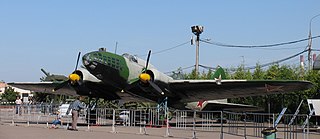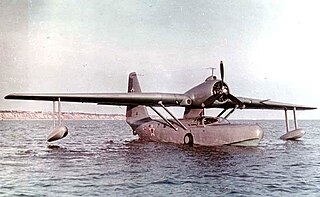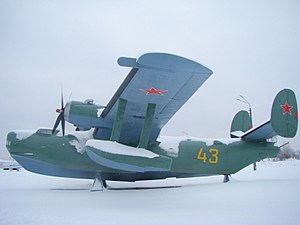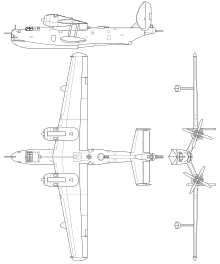
The Ilyushin Il-4 (DB-3F) was a Soviet twin-engined long-range bomber and torpedo bomber, widely used by the Soviet Air Force and Soviet Naval Aviation during World War II.

The Shenyang J-5 is a Chinese-built single-seat jet interceptor and fighter aircraft derived from the Soviet Mikoyan-Gurevich MiG-17. The J-5 was exported as the F-5 and was originally designated Dongfeng-101 and also Type 56 before being designated J-5 in 1964.

The Tupolev Tu-80 was a Soviet prototype for a longer-ranged version of the Tupolev Tu-4 bomber, an unlicensed, reverse engineered copy of the Boeing B-29 Superfortress. It was cancelled in 1949 in favor of the Tupolev Tu-85 program which offered even more range. The sole prototype was used in various test programs before finally being used as a target.

The Mikoyan-Gurevich MiG-8 Utka was a Soviet experimental aircraft. Built of wood, the aircraft was designed and built in 1945 to test the novel canard configuration. It also used a tricycle undercarriage, the first used by the OKB. It was modified to test a variety of vertical stabilizer and wingtip configurations and was later used as a liaison aircraft for many years by the design bureau.

The Yakovlev Yak-11 is a trainer aircraft used by the Soviet Air Force and other Soviet-influenced air forces from 1947 until 1962.

The Yakovlev UT-1 was a single-seater trainer aircraft used by the Soviet Air Force from 1937 until the late 1940s.

The Yakovlev Yak-24 is a Soviet twin-engine, tandem rotor, transport helicopter developed by Yakovlev in the 1950s. The Yak-24 saw limited use in the Soviet Air Force, and the exact number produced and duration of service are unknown due to inconsistencies in data.

The Beriev Be-8, was built by the Soviet Beriev OKB in 1947. It was a passenger/liaison amphibian aircraft with a layout similar to the Be-4 but substantially larger and heavier. It was a single engined parasol winged aircraft, with the wing installed on a thin pylon and a pair of short struts. Compared to the Be-4, the Be-8 was equipped with retractable landing gear, with cockpit and passenger cabins heated by an engine exhaust heat exchanger. The Be-8 was intended as a civil aircraft and carried no armament. First flight was on 3 December 1947, demonstrating good performance and of the two prototypes, one was demonstrated during the 1951 Soviet Aviation Day at Tushino.

The Beriev Be-30 is a Russian regional airliner and utility transport aircraft designed by the Beriev Design Bureau. It was developed specifically for Aeroflot local service routes using short, grass airstrips. It was also designed to be used in the light transport, aerial survey and air ambulance roles. It competed against the Antonov An-28 and the Czechoslovakian LET-410.

The Harbin Y-11 is a high wing twin-engine piston utility and geological survey aircraft built by Harbin Aircraft Manufacturing Corporation (HAMC).

The Yakovlev Yak-6 was a Soviet twin-engined utility aircraft, developed and built during World War II. It was used as a short-range light night bomber and a light transport.

The Beriev Be-112 is a proposed amphibian aircraft with two propeller engines, projected to carry 27 passengers. The Beriev firm lacks a production amphibian aircraft in this size.
The Yakovlev EG (Eksperimentalnyi Gelikopter), also commonly known as the Yak-M11FR-1 and Sh (Shootka), was an experimental aircraft with coaxial rotors. The prototype was first flown by V.V. Tezavrovsky in December 1947.
The Yakovlev Yak-5 was an experimental trainer aircraft designed by Yakovlev OKB in the Soviet Union, and first flown in 1944.

The Polikarpov NB was a Soviet twin-engined bomber designed during World War II. Only a single prototype had been built before the program was terminated upon the death of Nikolai Nikolaevich Polikarpov, the head of the aircraft's design bureau, in 1944.
The Ilyushin DB-4 or TsKB-56 was a Soviet twin-engined bomber aircraft of the early 1940s. It was a development of the Ilyushin DB-3 and was intended as a replacement for the earlier aircraft, but only two prototypes were built; engine problems and the need to concentrate production on existing types following the German invasion of the Soviet Union in June 1941 meant that no more examples were built.
The Yakovlev AIR-6 was a Soviet light utility aircraft of the 1930s. It was a single-engined high-wing monoplane designed by Alexander Sergeyevich Yakovlev, with 128 being built.

The Yakovlev AIR-7 was a prototype Soviet high performance light aircraft of the 1930s. It was a two-seat single-engined monoplane, which demonstrated excellent performance during testing. After the prototype almost crashed as a result of flutter, its designer, Alexander Sergeyevich Yakovlev suffered temporary disgrace and no production followed.
The Bartini T-117, was a twin-engined cargo aircraft designed by Robert Ludvigovich Bartini in the USSR from 1944-1948.
The Ilyushin Il-26 was a late 1940s project for a strategic heavy bomber by the Ilyushin Design Bureau. There were a variety of alternative engines proposed for the Il-26, including the 3,400 kW (4,500 hp) Shvetsov ASh-2TK piston engine and 4,500 kW (6,000 hp) Yakovlev M-501 diesel engine. The specifications varied according to the number and type of engines proposed.

















